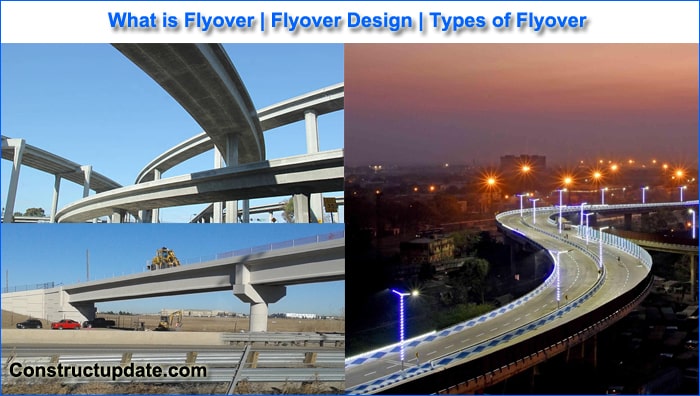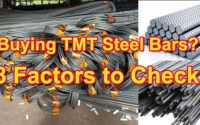What is Flyover | Flyover Construction Design | Flyover Types
What is Flyover?
A flyover is a bridge that crosses over another railroad or road. An overpass or high road bridge that crosses a highway or crossroads is another way to define a flyover.
Depending on how it will be used and where it will be erected, the Bridge and Flyover differ from one another.
Bridges are constructed to link two distinct locations; these locations can be found naturally in places like valleys, rivers, seas, or other bodies of water. In contrast, a flyover is intended to link two places in a congested area or at a traffic intersection. Facilities that allow movement over an obstruction without obstructing the way below include bridges and flyovers. The necessary passageway could be a road, railroad, or valley.
Types of Flyover
Road crossing Flyover
In this instance, the main road is used for swift traffic movement that is made to go at a high level by a bridge with ramps on both the left and right; the low traffic is forced to travel below. There is therefore no danger of an accident because the raffles are conducted on two levels.
Railway crossing Flyover
The flyover should always be kept beside the road at railroad crossings where there is heavy traffic density, either in terms of the volume of passing trains or the volume of vehicles on the road. Here, building the flyover is absolutely necessary.
Overpass Flyover
The term “overpass flyover” refers to a flyover that passes through an existing railroad or roadway while navigating obstacles. The primary purpose of overpass flyover construction is to keep other traffic away from the railway corridor (i.e vehicle and pedestrian traffic).
Underpass Flyover
The term “Underpass Flyover” refers to a flyover that passes through an existing railroad or roadway while navigating obstacles. The primary purpose of overpass flyover construction is to keep other traffic away from the railway corridor (i.e vehicle and pedestrian traffic).

Flyover Design:
The growing amount of traffic in major cities has been reduced and diverted in recent years thanks in large part to flyover design.
A hydraulic jack can be used to traverse the flyover vertically. Concrete and aluminium constructions make up the composite elements that make up the Flyover.
With the use of foundation piles, loads are moved into the soil’s depths. The structural components of the deck and pier are made out of steel and aluminium.
In highly populated locations where land acquisition expenses are high, flyover design is completed in order to execute the flyover.
Flyover design is a challenging subject that requires creativity and practicality to solve while meeting fundamental economic and security requirements.
The fundamental architectural principle that directs the construction of a flyover is that a structure should be designed to support every event that is probable to take place over its intended lifespan, with a defined probability.
The structure must also sustain stability over time and during unforeseeable events. It should also be sufficiently robust for the duration of its existence.
India has a long history of building steel flyovers and bridges. This is typically a flyover that connects great distances with one span or multiple span constructions and travels across low terrain or at intersections of roads.
For large spans, construction in steep places, or topographical conditions, the steel flyover is a good option. Steel and composite concrete are utilised to build short and larger flyovers.
Due to the large population, most Indian cities are overpopulated, and one of the biggest issues these cities face is traffic congestion.
Flyover construction is the answer to this issue. However, building flyovers with R.C.C. takes a long time, disrupts existing traffic, and has a low level of seismic resistance.
Flyovers made of steel pieces can be built to overcome this problem, but their initial building costs are expensive.
Three major feature components make up the flyover design
The flyover’s loaded weight is first transferred to the ground via the foundation, which is made up of components including columns (also known as piers) and abutments.
An abutment is a connection between the end of a flyover and a road that is supported on the ground and serves as support for the flyover’s last part.
Flyover Construction Process
In essence, a flyover is a bridge that spans over another section of the road. The measures listed below should be taken when building a flyover.
First, pier sites and cleaning areas are provided, and flyover alignment is defined. They will excavate to the proper depth and begin driving the pile if there are several abutments or pillars.
They will dig to the proper depth, compact the subgrade material, and potentially construct a levelling or rat slab if the construction site has a shallow footing.
On the lowest portion of the foundation, inside the suspension, or using the ground as a form, concrete is laid.
The next step is to set a pier column or an abutment concrete.
Then, construct the pier caps and abutments simultaneously.
The steel, precast, or box girders can then be installed.
The deck can then be constructed using prefabricated slabs or by laying a concrete deck.
The railroad or road, the guardrail, and the road markers can then be constructed.




